- Dolgo Crab
- Kerr Crab
- Trail Crab
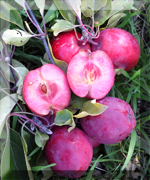 |
"Dolgo" A Siberian crab imported from Russia by Niels Hansen of South Dakota State University in 1897. "Dolgo" in Russian translates to "long". This describes the shape of the crimson colored fruit. Dolgo crab has a long history in Western Montana, valuable in many ways. While a lovely landscape plant, the extra tart and tasty flesh is prized for it's rosy colored jams and jellies, and high pectin content. The small 1.5" bittersharp fruits are also used to enhance blended ciders, and is also considered a very valuable pollinator in commercial orchards. This truly hardy applecrab is quite resistant to apple scab, rust and fireblight, very important characteristics in our Northern gardens. Used here as a hardy, disease resistant rootstock, one old matriarch from the 1910 plantings serves as a property corner on my farm and is considered one of my more valuable plants.
|
 |
This is a cross between Dolgo X Haralson developed at the Experimental Fam, Morden, Manitoba in 1952. The fruit ripens here in late September with a beautiful dark purple-red skin, 1.75" in diameter. Kerr crab is rated excellent for eating and canning, mellowing in storage until March or longer if hidden. Kerr is resistant to fireblight, very winter hardy and considered by many including myself as the best all purpose applecrab. A gift from Clayton Berg, Helena, MT in the '80s, Kerr crab is considered treasure on my small farm. A 200 tree cider orchard featuring Kerr Crab is on the To-Do list here, Spring 2010. The expression "Dynamite comes in small packages" describes this fruit very well and we recommend this treasure anywhere in Montana.
|
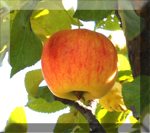 |
Another antique applecrab developed from a cross with Northern Queen X Rideau at the Central Experiment Farm, Ottawa, Ontario in 1913. Trail ripens here in late August, about 1.5" in diameter, with a beautiful splashed, striped orange-red over a pale yellow skin. Trail has a sweet, juicy flavor and rated as excellent for eating fresh and canning. Our Mother tree is located near the "Outhouse" a great spot to evaluate this very winter hardy, fireblight resistant applecrab, consensus and opinions range from "Do no disregard because of it's size" to "Yummmmmm". Recommended anywhere in Montana.
|
|
Back To Top

Pears are always a favorite with any backyard garden. These sugar sweet, juicy fruits are at their best when the the flesh gives slightly to the touch. Most varieties should be harvested slightly green and mellowed or finished in a cool place for five to ten days. While our winter temperatures and bacterial fireblight limit the use of Bartlett and many other commercial varieties, a good selection of hardy, gourmet quality pears are available. There are many antique, heirloom specimens surviving throughout Montana. Hybrids of Pyrus Communis and strains of Manchurian and Siberian pear have proven very winter hardy, producing quality fruit on both sides of the Continental Divide. While pears require cross pollination, a quick look at parentage and origin will generally indicate compatible varieties with overlapping bloom dates. The cultivars listed below are selections from the remnants of orchards planted over a century ago as well as releases from Canadian Breeding programs. Our pears are bud grafted to a hardy strain of Pyrus ussuriensis rootstocks.
- Flemish Beauty
- Frost
- Golden Spice
- Gourmet
- John
- Nova
- Patten
- Pioneer
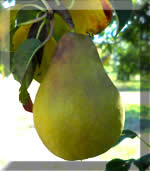 |
This antique pear was discovered as a chance seedling in Belgium circa: 1810. Flemish Beauty pears planted in Montana 100 years ago are a testament to this vigorous, winter hardy and productive fruit and also serves as our source of scion. The fruit is large, smooth, blushed and very attractive with tender and juicy flesh. We consider the flavor excellent as do friends from Eureka to Helena, ripening in mid-September. While serving as a valuable pollinator, Flemish Beauty is nearly self-fertile and highly recommended for northern kitchen orchards. Harvest when full size is attained and hold or finish for 10 days.
|
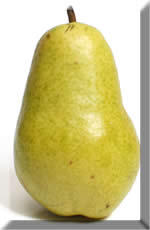 |
This selection was discovered on an old ranch in Montana's Bitterroot Valley. The old veteran was planted nearly 100 years ago and continues to win the "Blue Ribbon" at our county fair. The canopy is upright, vigorous and disease resistant. The fruit ripens in late September and is quite large, similar to Bartlett in size and shape, with sweet, juicy melting flesh. We are still trying to identify this variety and assigned the ranch name "Frost" with this treasure until positive ID is established. A favorite here and recommended for Western Montana.
|
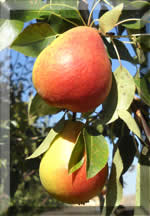 |
A release from the University of Minnesota breeding program in 1949, a gift from Clayton Berg, Helena, MT in the early '80s. These small 1.75" pears ripen in late september with a beautiful blush over a yellow background. The tough skin covers sweet, juicy, aromatic yet coarse flesh. Golden Spice is harvested when full yet firm and held in the cooler until finishing for a week to ten days. A very winter hardy and reliable bearer, these beautiful gems are prized in the galley when canned and one of our best fall ciders. Do not disregard this small package as the reliable heavy crop more than compensates for size. Highly recommended for our northern kitchen orchards.
|
 |
A release from South Dakota State University as a Pyrus communis hybrid. Gourmet is medium size and squatty or round pear with a greenish-yellow and thick yet tender skin. The flesh is yellowish, crisp, juicy and sweet, maturing in late September with a dessert quality flavor. Pollen-sterile.
|
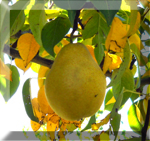 |
Released as a cross between Aspa X Siberian pear from the University of Saskatchewan in 1960. The fruit is considered large for hardy pears, blushing red over a greenish yellow tender skin. The cream colored flesh is juicy, aromatic, ripening in mid-September. John requres thinning here most years and must be harvested when filled out yet firm and mellowed for 7 to 10 days. A very winter hardy pear, valued in the galley for cooking and canning, recommended for either side of the Continental Divide.
|
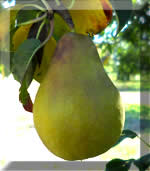 |
A selection of Pyrus communis from Eastern Canada, named and released as Nova from St. Lawrence Nurseries, New York. Planted here in 1991, Nova has proven winter hardy and a reliable producer of large round pears with a smooth, juicy, tender flesh. Ripening in late September, best harvested while a little green and finished inside, also holds well in cold storage. A large dessert quality pear and recommended for our northern kitchen orchards.
|
 |
Discovered in Iowa and believed to be of Pyrus ussuriensis parentage, Patten is considered very winter hardy and a valuable pollinator. One of the last to ripen here in late September, the fruit is large with a rosy blush over a yellow background covering a tender juicy flesh. Patten is rated excellent for a dessert pear and also valuable in the galley for canning, similar to Bartlett in character but resistant to fireblight. As with most varieties, best when harvested early and finished inside.
|
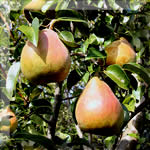 |
Pioneer #3 - This variety is one in a series developed by A.L. Young of Brooks, Alberta in 1936, as a Pyrus ussuriensis hybrid. The medium sized fruits ripen in late September with a dull red blush over a yellow-green background. Planted here in 1991 as a gift from Clayton Berg, Helena, MT, Pioneer#3 is very winter hardy and prolific, requires hand-thinning most years. The parentage renders the flesh somewhat course and grainy while winter hardiness and flavor give it value in our northern kitchen orchards.
|
|











